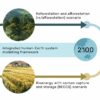A new study by Stanford University researchers has found that one of the most powerful earthquakes ever recorded in Alberta, Canada, was likely caused by oil and gas activity.
On November 30, 2022, a 5.6-magnitude earthquake shook the remote Peace River region in northwestern Alberta, a part of Canada’s oil sands region. Although people felt shaking more than 400 miles away, residents and businesses have not reported injuries or damage.
Energy regulators for the region described the earthquake as a natural tectonic event. A rigorous new analysis by Stanford geophysicists suggests, however, that oil industry activity—specifically, disposal of wastewater deep underground—most likely triggered the tremor. Three slightly smaller earthquakes struck the same area again on March 16, less than a mile from last year’s big quake.
Researchers have long linked earthquakes to fracking and wastewater disposal in other parts of Alberta and British Columbia, provinces that straddle the Canadian Rocky Mountains. The new study, published March 23 in Geophysical Research Letters, is the first to link such a large earthquake to human activities this far away from the mountain range, in a region where industry centers on exploiting oil sands rather than fracking for natural gas.
The results have safety implications for ongoing and future energy-related operations, such as the underground storage of carbon dioxide to help mitigate climate change.
“Earthquakes of similar magnitude to the Peace River event could be damaging, even deadly, if they happened in more populated areas,” said study lead author Ryan Schultz, who recently completed his Ph.D. in geophysics at the Stanford Doerr School of Sustainability. “It is important that we understand the mechanics involved and how to avoid inducing more of these events.”
“The Peace River earthquake caught our interest because it occurred in an unusual place,” said co-author William Ellsworth, a research professor of geophysics and co-director of the Stanford Center for Induced and Triggered Seismicity. “Multiple lines of compelling evidence point to this quake as being man-made.”
Finding the culprit
Over recent decades, scientists have documented hundreds of earthquakes induced by oil and gas operations worldwide, especially in the United States. To assess the origins of the Peace River earthquake, the Stanford team and colleagues employed a well-proven approach that considers seismic events’ details and context, including location, depth, timing, regional history of background earthquakes, and records of industrial activity.
Operations in the Peace River area center on extracting a thick, black, sticky form of oil known as bitumen. To mobilize the tar-like substance for easier pumping up to the surface, workers inject huge amounts of hot water or solvents underground, where it can mix with heavy metals, hydrocarbons, and harmful chemicals. The most economical way to dispose of this wastewater is by re-injecting it underground. Since bitumen recovery operations began in the Peace River study area in the 1980s, about 40,000 Olympic swimming pools (100 million cubic meters) of wastewater have been injected underground.
The researchers compared publicly available information about wastewater disposal activities in Peace River to ground deformation measured by satellite and regional seismic monitors. “The Alberta government deserves credit for its transparency for providing public access to production and disposal data,” said Ellsworth. Overall, the results tied frequent, minor earthquakes to wastewater disposal from bitumen recovery going back almost a decade, strongly implicating the big November 2022 temblor as well.
A key piece of evidence came via satellite observations, which showed a dramatic 3.4-centimeter uplift in the ground at the time of the November quake. This elevation change proved consistent with seismic movement along a previously undocumented fault line—a fracture between giant blocks of rock deep underground where most earthquakes occur. According to the study, the high volume of disposed wastewater had increased water pressure on the fault, weakened it, and made it prone to slip.
Future earthquake risk
The 2022 Peace River quake is “a cautionary tale,” Schultz said, for a region where government and industry aim to expand hydrogen production and carbon capture and storage in the coming years while continuing oil-sands wastewater disposal.
One proposed approach to producing hydrogen involves splitting natural gas into hydrogen and carbon dioxide, then capturing the CO2 and compressing it into a supercritical fluid for long-term storage. “Switching to ‘blue’ hydrogen will require disposal by injection of unprecedented volumes of supercritical carbon dioxide,” said Schultz. Like the wastewater from bitumen production, injecting carbon dioxide underground could trigger seismicity.
The Stanford researchers hope that expanding seismic monitoring in active petroleum recovery sites, in Peace River and elsewhere, will help scientists better understand when and how human activity leads to earthquakes. Ellsworth said, “It is vitally important that we understand all aspects of induced seismicity, from basic physical mechanisms to risk management.”
More information:
Ryan Schultz et al, Disposal From In Situ Bitumen Recovery Induced the M L 5.6 Peace River Earthquake, Geophysical Research Letters (2023). DOI: 10.1029/2023GL102940
Provided by
Stanford University
Citation:
Oil industry activity likely triggered large Alberta earthquake, finds study (2023, March 24)



